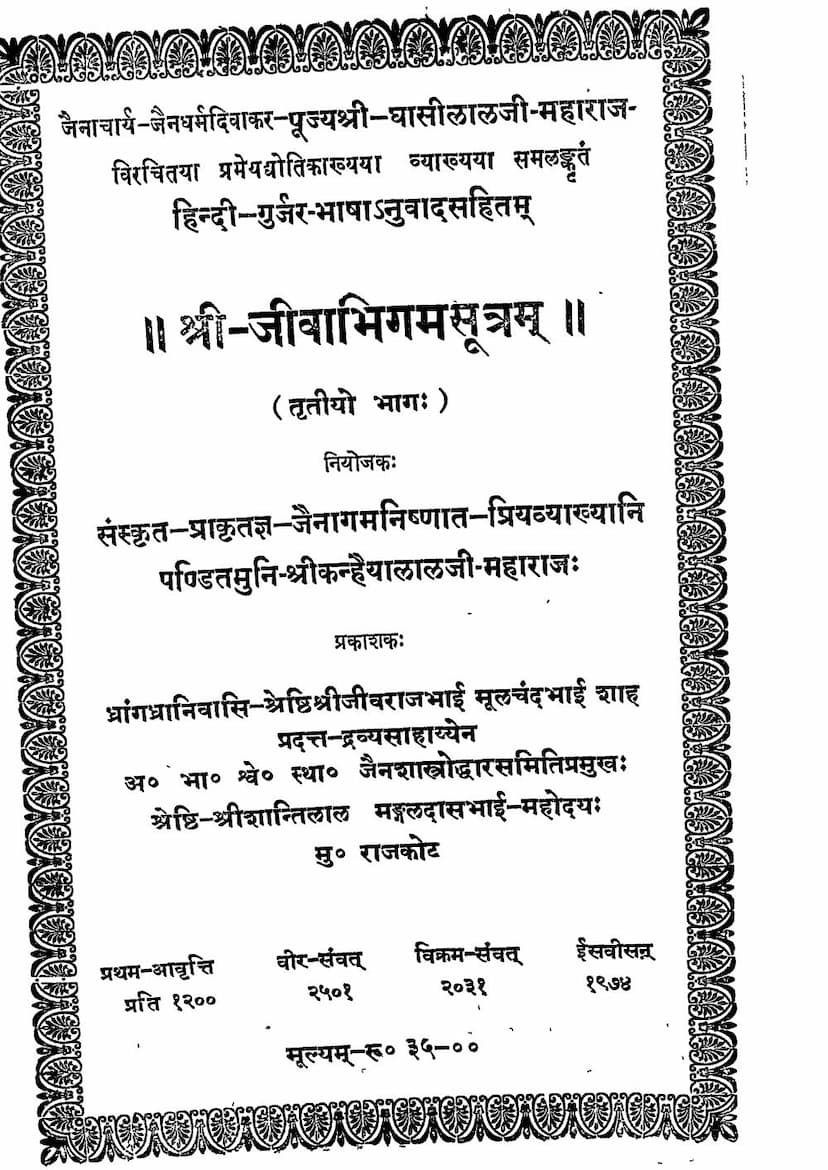Jivajivabhigamsutra Part 03
Added to library: September 2, 2025

Summary
This comprehensive summary outlines the content of Part 03 of the Jivajivabhigamsutra, compiled by Ghasilal Maharaj and published by A B Shwetambar Sthanakwasi Jain Shastroddhar Samiti. The provided text details the elaborate descriptions of various elements within the Jain cosmological framework, primarily focusing on the descriptions of Jambu-dwipa and its features, as well as the divine beings inhabiting these realms.
Key Themes and Content:
- Detailed Cosmological Descriptions: The text provides incredibly granular descriptions of various geographical and architectural elements within the Jain universe, particularly focusing on Jambu-dwipa. This includes:
- Forests (Vanapanda): Extensive descriptions of various types of forests, their characteristics, and the celestial beings (Vanavyantara Devas and Devis) residing within them.
- Lakes and Water Bodies (Vapya, Pushkarini, Sarasi etc.): Detailed accounts of numerous types of lakes, ponds, and water bodies, describing their size, shape, water quality, the flora and fauna within them, and their ornamentation.
- Architectural Marvels: Elaborate descriptions of structures like staircases (trisopan), gates (torana), pavilions (mandapaka), residences (griha), and other decorative elements, all crafted from precious gems and metals.
- Geographical Features: Mentions of mountains (parvata), rivers (mahanadi), and other geographical formations.
- Divine Beings and Their Abodes: The text frequently references various classes of celestial beings:
- Vanavyantara Devas and Devis: Their presence, activities, and the realms they inhabit are described.
- Samarthka Devas and Their Families: Detailed descriptions of the retinue of the principal deity (Vijayadeva), including his four thousand Samanikas, their respective queens (Agra-mahishi), the three councils (Parishad), seven divisions (Anika) and their chiefs (Anikadhipati), and sixteen thousand attendants (Ayurakshak Devas).
- Celestial Decorations and Offerings: The text details the placement and nature of various items like thrones (simhasana), banners (dhvaja), parasols (chhatra), chamaras (fly-whisks), musical instruments (ghanta, mridanga), and offerings (puṣpa, gandha, mālā, kankana, ratna) associated with these divine beings and their abodes.
- Specific Locations and Their Features:
- Vijaya-dwara: An extensive description of the gate named Vijaya, its dimensions, materials, and surrounding structures.
- Upapata-sabha: The abode of Vijayadeva, its opulent description, and the arrangements for his divine activities.
- Alankarika-sabha: The hall of adornment, highlighting the meticulous preparation of Vijayadeva's attire and accouterments.
- Vyavasaya-sabha: The hall of occupation or business, where Vijayadeva is depicted as engaging with a book (Pustaka-ratna).
- Nanda-Pushkarini: A description of a large lake associated with the hall of occupation.
- Siddha-Ayatan: A sacred sanctuary where the statues (pratima) of Tirthankaras are described in great detail.
- Su-dharma Sabha: The celestial assembly hall of the Vanavyantara deities, with its own intricate descriptions of surrounding features like lakes, pavilions, and assembly halls.
- Mani-pithika and Simhasana: The platforms and thrones where the deities sit, described with immense detail regarding their materials and craftsmanship.
- Yamakaparvata and Nila-hrada: Descriptions of mountains and lakes in the context of Uttar-Kuru, including their dimensions and associated features.
- Artistic and Sensory Details: The text employs rich sensory language to paint a vivid picture of these celestial realms. Descriptions often include:
- Colors and Materials: Mention of gold, silver, various gems (vajra, vaidūrya, lohitaksha, ratna), and their intricate use in construction and decoration.
- Music and Dance: References to celestial music and dances performed by divine beings.
- Fragrance and Beauty: Descriptions of fragrant flowers, sandalwood, and the overall aesthetic beauty of the celestial environment.
- Symbolism and Ritual: The mention of eight auspicious symbols (ashta-mangal) and their placement suggests ritualistic or symbolic significance.
- Numerical Precision: The text is characterized by its precise use of numbers for measurements (yojanas, krosas, dhanush), quantities (number of statues, types of jewels), and proportions, reflecting a structured and detailed cosmological understanding.
- The Concept of 'Yathavata': The repeated phrase "yadṛśī... tādṛśī" (as is... so is) signifies that descriptions of one element are to be applied to another similar element, indicating a systematic and comparative approach to describing the vast Jain universe.
- Enduring Nature of Places: The text emphasizes the eternal nature of certain places, like the gates (e.g., Vijaya-dwara), suggesting they are beyond the cycles of creation and destruction.
Structure and Presentation:
- Commentary (Prameyadyotikā): The text includes a commentary, "Prameyadyotikā," which elaborates on the original sutras, providing explanations and clarifications.
- Multiple Languages: The publication includes translations or commentaries in Hindi and Gujarati alongside the original Sanskrit and Prakrit.
- Dedication: The publication is dedicated to the memory of Seth Shri Jivrajbhai Mulchandbhai Shah, highlighting the importance of patrons in the dissemination of Jain scriptures.
- Table of Contents (Vishayanukramnika): The detailed table of contents indicates the methodical organization of the complex subject matter.
In essence, this part of the Jivajivabhigamsutra, through its intricate and often poetic descriptions, aims to provide the Jain follower with a profound understanding of the vastness, beauty, and order of the Jain cosmos, emphasizing the meticulous categorization and description of reality, both mundane and divine.